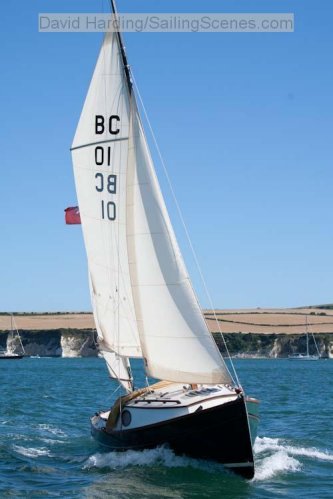|

|
Video of a very slow, gentle drift past Brownsea Island with views of Poole and other islands in the harbour.
|
View up the mast, showing the full length batten giving the sail its distinctive roach.
|
I am grabbing every opportunity for a sail in this very shortened season. We had two good days forecast so I set off in the afternoon for Poole (a two hour plus drive, so not a minor trip.) Sailed out through a squad of Gurkhas who are having sail training at Rockley. They seemed to be having a whale of a time. I had meant to motor out, but the engine conked out just as I had cast off the mooring chain, so I had to tack out through the Gurkhas in a narrow channel. Managed it with few mishaps.
I passed an anchored Red Fox yacht, with a grinning skipper leaning over the back. As I passed him he called out "I sat in your cabin in Cardigan a few weeks ago!"
After simply sailng round the harbour I anchored between Brownsea and Furzey islands for the night. The 8kg Britany anchor seems to hold fine, and I will be a lot stronger after I have hauled it and its chain aboard a few times (or possibly dead). Very still, starry night and a sunny dawn. That is unusual, dawn is often grey, cold and a bit grim. I set sail in the tiny breeze and filmed the video above as we drifted past Brownsea Island.
The breeze picked up later and I tried two new things.
First I set off across the Harbour on a close reach, lashed the tiller in the middle and sat back to see what happened. I was delighted that we sailed for about fifteen minutes right across the harbour without touching the tiller or a sheet. I really didn't think she would hold her course like that, lacking any keel at all, but she was excellent. Each time she rounded slightly into the wind, the mizzen would flutter a bit and she would drop back onto her course.


Next I plucked up courage and pumped out the ballast. Takes about fifteen minutes and there were still a few litres left that didn't want to go. Sailed for about half an hour and didn't really notice any significant difference in either handling or speed. Then a stronger puff pushed us over to quite a steep angle. Nothing dramatic, but more than I had experienced in much stronger winds. So I ended the experiment, opened the inlet and refilled her. That took about ten minutes, and I noticed that she took on more water than before, filling right to the underside of the hatch. Now we don't lean anymore.
I sailed out into the sea and round to Studland beach. I anchored there and gave her a much needed scrub in the sun. A remarkable amount of gunk comes on board, particulalry from the anchor. So I dug out my little Indian galvanised bucket (they laughed at me when I bought that in Guahati and brought it back as hand luggage, but it is fantastic, far better than plastic) and swabbed her down. Looked good for about ten minutes.

I also experimented with getting back on board using the step in the rudder blade. I can't do it. Standing on the step, the top of the transom is at chest level and hauling aboard would be near impossible. If the top of the steel rudder assembly could be made horizontal, maybe with a couple of wooden blocks, then that could be used as a second step and it would be possible. You would still be dealing with an overhanging transome, so in anything but flat conditions it would still be hard. I think I will install a transom ladder over the winter.
From Studland I reached at 6kts back to the harbour, beating a couple of yachts on the way. Went firmly aground in the hrabour (it was low spring tide) but managed to hop off and haul her into deeper water. Then back home to the mooring.
 The photo shows Daisy Grace anchored off Arne with the Drascombe Caboteur Hippo anchored beyond. A couple of other Drascombes joined her later. I think there must have been a rally on. We waved but couldn't talk over the wind.
The photo shows Daisy Grace anchored off Arne with the Drascombe Caboteur Hippo anchored beyond. A couple of other Drascombes joined her later. I think there must have been a rally on. We waved but couldn't talk over the wind.














